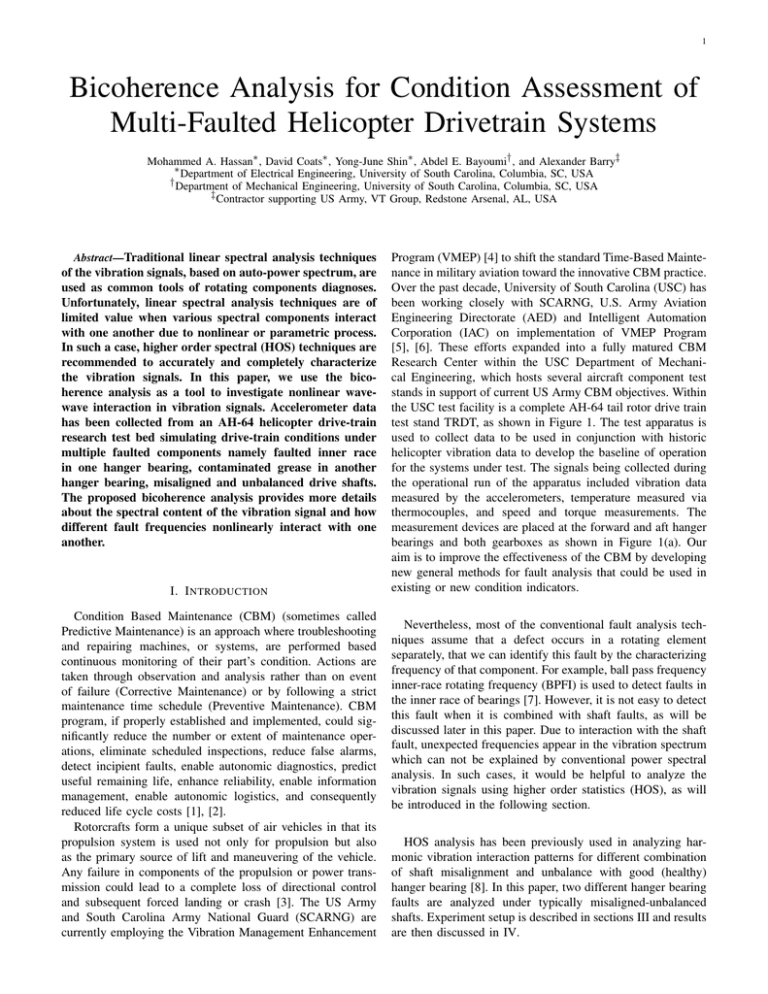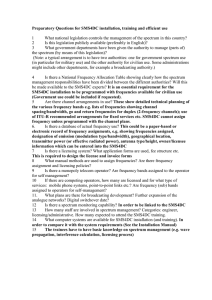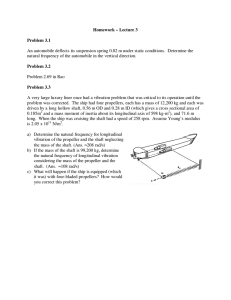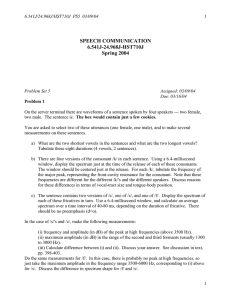Bicoherence Analysis for Condition Assessment of Multi-Faulted Helicopter Drivetrain Systems
advertisement

1
Bicoherence Analysis for Condition Assessment of
Multi-Faulted Helicopter Drivetrain Systems
Mohammed A. Hassan∗ , David Coats∗ , Yong-June Shin∗ , Abdel E. Bayoumi† , and Alexander Barry‡
∗ Department of Electrical Engineering, University of South Carolina, Columbia, SC, USA
† Department of Mechanical Engineering, University of South Carolina, Columbia, SC, USA
‡ Contractor supporting US Army, VT Group, Redstone Arsenal, AL, USA
Abstract—Traditional linear spectral analysis techniques
of the vibration signals, based on auto-power spectrum, are
used as common tools of rotating components diagnoses.
Unfortunately, linear spectral analysis techniques are of
limited value when various spectral components interact
with one another due to nonlinear or parametric process.
In such a case, higher order spectral (HOS) techniques are
recommended to accurately and completely characterize
the vibration signals. In this paper, we use the bicoherence analysis as a tool to investigate nonlinear wavewave interaction in vibration signals. Accelerometer data
has been collected from an AH-64 helicopter drive-train
research test bed simulating drive-train conditions under
multiple faulted components namely faulted inner race
in one hanger bearing, contaminated grease in another
hanger bearing, misaligned and unbalanced drive shafts.
The proposed bicoherence analysis provides more details
about the spectral content of the vibration signal and how
different fault frequencies nonlinearly interact with one
another.
I. I NTRODUCTION
Condition Based Maintenance (CBM) (sometimes called
Predictive Maintenance) is an approach where troubleshooting
and repairing machines, or systems, are performed based
continuous monitoring of their part’s condition. Actions are
taken through observation and analysis rather than on event
of failure (Corrective Maintenance) or by following a strict
maintenance time schedule (Preventive Maintenance). CBM
program, if properly established and implemented, could significantly reduce the number or extent of maintenance operations, eliminate scheduled inspections, reduce false alarms,
detect incipient faults, enable autonomic diagnostics, predict
useful remaining life, enhance reliability, enable information
management, enable autonomic logistics, and consequently
reduced life cycle costs [1], [2].
Rotorcrafts form a unique subset of air vehicles in that its
propulsion system is used not only for propulsion but also
as the primary source of lift and maneuvering of the vehicle.
Any failure in components of the propulsion or power transmission could lead to a complete loss of directional control
and subsequent forced landing or crash [3]. The US Army
and South Carolina Army National Guard (SCARNG) are
currently employing the Vibration Management Enhancement
Program (VMEP) [4] to shift the standard Time-Based Maintenance in military aviation toward the innovative CBM practice.
Over the past decade, University of South Carolina (USC) has
been working closely with SCARNG, U.S. Army Aviation
Engineering Directorate (AED) and Intelligent Automation
Corporation (IAC) on implementation of VMEP Program
[5], [6]. These efforts expanded into a fully matured CBM
Research Center within the USC Department of Mechanical Engineering, which hosts several aircraft component test
stands in support of current US Army CBM objectives. Within
the USC test facility is a complete AH-64 tail rotor drive train
test stand TRDT, as shown in Figure 1. The test apparatus is
used to collect data to be used in conjunction with historic
helicopter vibration data to develop the baseline of operation
for the systems under test. The signals being collected during
the operational run of the apparatus included vibration data
measured by the accelerometers, temperature measured via
thermocouples, and speed and torque measurements. The
measurement devices are placed at the forward and aft hanger
bearings and both gearboxes as shown in Figure 1(a). Our
aim is to improve the effectiveness of the CBM by developing
new general methods for fault analysis that could be used in
existing or new condition indicators.
Nevertheless, most of the conventional fault analysis techniques assume that a defect occurs in a rotating element
separately, that we can identify this fault by the characterizing
frequency of that component. For example, ball pass frequency
inner-race rotating frequency (BPFI) is used to detect faults in
the inner race of bearings [7]. However, it is not easy to detect
this fault when it is combined with shaft faults, as will be
discussed later in this paper. Due to interaction with the shaft
fault, unexpected frequencies appear in the vibration spectrum
which can not be explained by conventional power spectral
analysis. In such cases, it would be helpful to analyze the
vibration signals using higher order statistics (HOS), as will
be introduced in the following section.
HOS analysis has been previously used in analyzing harmonic vibration interaction patterns for different combination
of shaft misalignment and unbalance with good (healthy)
hanger bearing [8]. In this paper, two different hanger bearing
faults are analyzed under typically misaligned-unbalanced
shafts. Experiment setup is described in sections III and results
are then discussed in IV.
2
(a)
Fig. 1.
(b)
(a) TRDT test stand at USC and (b) Actual TRDT on AH-64
II. B ISPECTRUM AND B ICOHERENCE
Vibration signals from mechanical systems are realizations
of random process. Just as random variables are characterized
by certain expected values or moments, random processes are
characterized by their mean values, correlation function, and
various higher order correlation functions. Alternatively, random processes may be characterized by the Fourier transforms
of the various order correlation function [9]. For a stationary
continuous vibration signal x(t), the first order (linear) autocorrelation function Rxx (τ ) and the power spectrum Sxx (f )
are Fourier transform pairs according to Wiener-Khinchin
theorem [10], and can be estimated by (1) and (2).
Rxx (τ ) = E{x∗ (t)x(t + τ )}
(1)
Sxx (f ) = E{X ∗ (f )X(f )} = E{|X(f )|2 }
(2)
The auto-power spectrum, Sxx (f ), has the dimensions of
mean square values/Hz and it indicates how the mean square
value is distributed over frequency. Auto-power spectrum is
one of the most commonly used tools in spectrum analysis of
vibration signals [11], [12].
Similarly, bispectrum Sxxx (f1 , f2 ) is the Fourier transform
of the second-order correlation function Rxxx (τ1 , τ2 ), as given
in (3) and (4), and it describes second-order statistical dependence between spectral components of signal x(t).
Rxxx (τ1 , τ2 ) = E{x∗ (t)x(t + τ1 )x(t + τ2 )}
Sxxx (f1 , f2 ) = E{X(f1 )X(f2 )X ∗ (f3 = f1 + f2 )}
(3)
(4)
M
m
The advantage of bispectrum over linear power spectral
analysis is its ability to characterize quadratic nonlinearities
in monitored systems [13], [14]. One of the characteristics
of nonlinearities is that various frequencies “mix” to form
new combinations of “sum” and “difference” frequencies,
as depicted in Figure 2. An important signature is based
on the fact that there exists a phase coherence, or phase
coupling, between the primary interacting frequencies and
the resultant new sum and difference frequencies [15]. Since
all phase information is destroyed in computing the classical
power spectrum, the power spectrum is incapable of detecting
the phase coupling signature. The bispectrum describes this
correlation between the three waves (source and the result
of interaction process) in two-dimensional frequency space
(f1 − f2 ).
Fig. 2.
signals
Effect of nonlinear system on frequency mix (interaction) of input
The definition of the bispectrum in (4) shows how the
bispectrum measures the statistical dependence between three
waves. That is, Sxxx (f1 , f2 ) will be zero unless the following
two conditions are met:
1. Waves must be present at the frequencies f1 , f2 , and f1 +f2 .
That is, X(f1 ), X(f2 ), and X(f1 + f2 ) must be non-zero.
2. A phase coherence must be present between the three
frequencies f1 , f2 , and f1 + f2 .
If waves present at f1 , f2 , and f1 + f2 are spontaneously
excited independent waves, each wave will be characterized
by statistical independent random phase. Thus, the sum phase
of the three spectral components will be randomly distributed
over (−π, π). When a statistical averaging denoted by the
expectation operator is carried out, the bispectrum will vanish
due to the random phase mixing effect. On the other hand, if
the three spectral components are nonlinearly coupled to each
3
other, the total phase of three waves will not be random at
all, although phases of each wave are randomly changing for
each realization. Consequently, the statistical averaging will
not lead to a zero value of the bispectrum.
The magnitude of the bispectrum at coordinate point
(f1 , f2 ) measures the degree of phase coherence between
the three frequency components f1 , f2 ,and f3 . However, this
magnitude is also dependent on the magnitude of the relevant
Fourier coefficients. Therefore, a common function used to
normalize the bispectrum is the bicoherence b(f1 , f2 ) [13].
|Sxxx (f1 , f2 )|2
: f3 = f1 + f2
E{|X(f1 )X(f2 )|2 }E{|X(f3 )|2 }
(5)
The bicoherence is independent of the magnitude of the
fourier transform and bounded by 0 ≤ b( f1 , f2 ) ≤ 1, where 1
means complete coupling and 0 means no coupling at all.
b2 (f1 , f2 ) =
III. E XPERIMENTAL SET UP AND DATA DESCRIPTION
The TRDT test stand, shown in Figure 1(a), is a full-scale
AH-64 Helicopter tail rotor driveshaft apparatus for on-site
data collection and analysis. The apparatus is a dynamometric
configuration which includes an AC induction motor rated at
400hp controlled by variable frequency drive to provide input
drive to the configuration, a multi-shaft drive train supported
by hanger bearings, flex couplings at shaft joining points, two
gearboxes, and an absorption motor of matching rating to
simulate the torque loads that would be applied by the tail
rotor blade. Vibration signals denoted as FHB and AHB, as
shown in Figure 1, are collected from forward and aft hanger
bearings at two minutes intervals at a sampling rate of 48 kHz.
Seeded hanger bearing faults testing was designed to include
multi-faulted drive train components with two faulted hanger
bearings running at the same time, one with a spalled inner
race in the FHB position and one with contaminated grease
with coarse grit sand run in the AHB position. This is done
with 1.3◦ misalignment between drive shafts #3 and #4, 1.3◦
misalignment between drive shafts #4 and #5, and unbalanced
drive shafts #3, #4 and #5 by 0.140 oz-in, 0.135 oz-in 0.190
oz-in respectively. The forward hanger bearing is machined to
replicate a bearing with a spalled inner race as shown in Figure
3. All machining was done at the army research laboratory
(ARL). The holes were milled into the inner race with a ball
mill and were machined to the specs summarized in Table I.
TABLE I
S PALLED I NNER R ACE I NFORMATION
Spall
Spall diameter
(inch)
Spall depth
(inch)
#1
#2
#3
0.030
0.031
0.031
0.017
0.016
0.017
IN THE
FHB
Distance from
left shoulder
(inch)
0.1400
0.1956
0.2567
POSITION
Distance from
right shoulder
(inch)
0.2538
0.1985
0.1376
The AHB has coarse grit contaminated grease mixed in a
ratio of 5% by volume of the grease. This seeded fault is also
done at the ARL with a representative sand contaminant consist of crushed quartz with the total particle size distribution
as shown in Table II.
Fig. 3.
Spalled Inner race seeded fault (FHB position)
TABLE II
C OARSE G RIT C ONTAMINATED G REASE M IXTURE IN THE AHB
Size (µ)
1
2
3
4
5
7
10
20
40
80
120
180
200
POSITION
Volume fraction (%)
0.6 to 1.0
2.2 to 3.7
4.2 to 6.0
6.2 to 8.2
5.0 to 10.5
12.0 to 14.0
17.0 to 22.0
32.0 to 36.0
57.0 to 61.0
87.5 to 89.5
97.0 to 98.0
99.5 to 100
100
IV. R ESULTS AND DISCUSSION
A. Spalled Inner Race Hanger Bearing
The power spectrum of the spalled inner race FHB is shown
in Figure 4. It is estimated using average over ensemble of
vibration data collected every two minutes over a 60 minutes
run under output torque at the tail rotor equal to 111 lb-ft,
and plotted with 1.465Hz frequency resolution. Due to the
misaligned-unbalanced drive shafts, high magnitudes of the
vibration exist at the 80.57Hz, 162.5Hz, and 243.2Hz as shown
in Figure 4. These frequencies match 1SO , 2SO, and 3SO
reported in Table III by the Aviation Engineering Directorate
(AED). These shaft harmonics are typically used to describe
shaft misalignment and unbalance by many vibration-analysis
test-books [7], [16]. According to text books, one should also
expect to see the ball pass inner-race frequency (BPFI) that
characterizes the faulted hanger bearing under test, 441Hz as
reported in Table III. However, it is not easy to detect the
BPFI frequency in Figure 4. The highest non-shaft frequencies
in this spectrum is at 684.1Hz and 279.8Hz which do not
match any frequency in Table III. Therefore, it is obvious
that linear spectral analysis fails to detect hanger bearing fault
when it is combined with shaft faults, and also fails to relate
all frequencies in the spectrum to known fault source.
4
Fig. 4.
shafts
Power spectrum of the spalled FHB with misaligned-unbalanced
TABLE III
TRDT
COMPONENTS ROTATING FREQUENCIES PROVIDED BY
AED
Fig. 5.
Bicoherence of the FHB with misaligned-unbalanced shafts
(a)
(b)
The FHB vibration is then analyzed using bicoherence
spectrum as shown in Figure 5. It can be seen that a number
of shaft order harmonics exist along f2 = 80.57Hz, 161.1Hz,
243.2Hz. Along each of those frequencies in f2 direction, there
are number of quadratic coupling (nonlinear interaction) with
other frequencies, in f1 direction, including shaft harmonics
and non-shaft frequencies. Shaft harmonic interaction patterns
is used previously to assess drive shaft health conditions [8].
In our case here, we are concerned more about any interaction
with non-shaft frequencies that might be related to hanger
bearing faults.
For a better view, bicoherence spectrum is plotted by fixing
f2 to equal 161.1Hz and 243.2Hz and varying f1 to investigate
all frequencies interacting with those 2SO and 3SO including
non-shaft frequencies. From Figure 6(b), bicoherence spectrum has a peak located at b2 (f = 243.2Hz, f = 440.9Hz) =
0.4305, which reflects interaction between the 3SO and the
BPFI in Table III. The result of this interaction is a new
frequency at the “sum” of the two coordinate frequencies
which equal to 684.1Hz. This explains the presence of a
spectral peak at this frequency in the power spectrum of the
FHB vibration in Figure 4. From Figure 6(a), the value of
b2 (f = 161.1Hz, f = 279.8Hz) = 0.1669 explains the source
of 279.8Hz frequency in Figure 4. This bicoherence peak is
due to interaction between SO2 and BPFI, but due to the the
Fig. 6. Bicoherence of the FHB vibration showing frequency interactions
with (a) f2 = 161.1Hz, and (b) f2 = 243.2Hz
way bicoherence is estimated in (4) and (5) it shows the least
two frequencies (f1 and f2 ) in the three-wave coupled group
(f1 , f2 , and f3 = f1 + f2 ). Therefore, b2 (f = 161.1Hz, f =
279.8Hz) is indication of interaction between 2SO and the
BPFI to create the “difference” frequency at 279.8Hz which
appears in the power spectrum in Figure 4.
From the above discussion, it is clear that bicoherence
spectrum is more useful in both detecting the hanger bearing
fault and giving better explanation about source of frequencies
in the vibration spectrum.
B. Coarse Grit Contaminated Grease Hanger Bearing
The power spectrum of the coarse grit contaminated grease
AHB is shown in Figure 7. This fault does not have particular
5
frequency to characterize it in the power spectrum. Although
it is clear from the vibration magnitudes that there is a fault
in this bearing, the power spectrum still can not explain the
source of generating high vibration magnitudes at 279.8Hz,
360.4Hz, 440.9Hz, 522.9Hz, 603.6Hz, 684.1Hz, 927.2Hz, and
some other higher frequencies, which are spaced by the shaft
rotating frequency 80.57Hz. The only frequency that can be
related to TRDT frequencies in Table III is 440.9Hz, the BPFI
of the faulted inner-race FHB.
Fig. 8.
Fig. 7.
Power spectrum of the coarse grit contaminated grease AHB
The bicoherence spectrum of the AHB vibration is shown in
Figure 8 with vibration wave-wave interaction among a wide
spread of shaft harmonics and non-harmonics frequencies.
This indicates a very high nonlinear rotating medium that
results in this large amount of interaction. Although it is hard
to follow each coordinate point in the 3D bicoherence plot, we
observe that there are particular frequencies over f2 direction
that interact with other frequencies, namely Shaft Orders 1SO,
2SO, 3SO, ...,8SO, and 279.8Hz, 360.4Hz, 440.9Hz, 522.9Hz,
603.6Hz, 684.1Hz. Again, for a better view, bicoherence
spectrum is plotted along f2 = 80.75Hz and 279.8Hz as
shown in Figure 9. The trend of vibration interaction is clear
that shaft harmonics tend to interact with the BPFI group that
transferred from the FHB through drive shaft #4, with no other
obvious source of interaction. The higher magnitude of the
BPFI group of frequencies in the AHB spectrum in Figure 7
can be explain by multiple coordinate points of interaction
in the bicoherence spectrum between shaft harmonics and
frequencies generated at FHB. For example, 522.9Hz can be
generated by frequency mix between the following coordinate
pairs (279.8+3SO), (440.9+1SO), and (684.1-1SO).
V.
CONCLUSION
In this paper, bicoherence analysis has been used as a tool
to investigate nonlinear wave-wave interaction in vibration
signals from an AH-64 helicopter drive-train simulating accelerated drive-train conditions under multiple faulted components. TRDT has been tested typically with faulted inner
race in one hanger bearing, contaminated grease in another
hanger bearing, misaligned and unbalanced drive shafts. The
proposed bicoherence analysis provided more details about the
spectral content of the vibration signal and how different fault
frequencies nonlinearly interact with one another. Compared to
linear power spectrum, bicoherence enables us to both detect
the hanger bearing faults and to explain the source of new
generated frequencies appear in the power spectrum of the
Bicoherence the coarse grit contaminated grease AHB
(a)
(b)
Fig. 9. Bicoherence of the AHB vibration showing interaction with (a)
f2 = 80.57Hz, and (b) f2 = 279.8Hz
vibration signal. Studying these cases by use of bicoherence
spectrum was useful to closing the loop between physical
source of non-linearities and resultant frequencies showing up
in the power spectrum of the vibration signal.
Since bicoherence showed better capability than linear
power spectral analysis in studying this extreme case of multifaults, future work would extend the study to include more
faulted hanger bearing but with single shaft fault (misalignment or unbalance only). Since shaft faults are typical in
many cases with the first three shaft harmonics dominating
(1SO, 2SO, 3SO), focusing on vibration interaction with those
particular frequencies in the bicoherence of hanger bearing is
also recommended and can carry more useful information than
the conventional power spectrum.
6
ACKNOWLEDGMENT
This research is funded by the South Carolina Army
National Guard and United States Army Aviation and
Missile Command via the Conditioned-Based Maintenance
(CBM) Research Center at the University of South CarolinaColumbia. Also, this research is partially supported by the
Egyptian government via the Government Mission Program
for Mohammed Hassan, and National Science Foundation
Faculty Early Career Development (CAREER) Program as
well as a National Science Foundation Graduate Research
Fellowship for David Coats.
R EFERENCES
[1] A. Bayoumi, W. Ranson, L. Eisner, and L.E. Grant, “Cost and effectiveness analysis of the AH-64 and UH-60 on-board vibrations monitoring
system,” IEEE Aerospace Conference, pp. 3921-3940, Mar. 2005.
[2] V. Blechertas, A. Bayoumi, N. Goodman, R. Shah, and Yong-June Shin,
“CBM Fundamental Research at the University of South Carolina: A
Systematic Approach to U.S. Army Rotorcraft CBM and the Resulting
Tangible Benefits,” Proceedings of AHS International Specialists’ Meeting on Condition Based Maintenance, Huntsville, AL, Feb. 2009.
[3] James J. Zakrajsek,et al. “Rotorcraft Health Management Issues and
Challenges,” First International Forum on Integrated System Health
Engineering and Management in Aerospace, Napa, California, February
2006.
[4] P. Grabill, T. Brotherton, J. Berry, and L. Grant, “The US Army and
National Guard Vibration Management Enhancement Program (VMEP):
Data Analysis and Statistical Results,” American Helicopter Society 58th
Annual Forum, Montreal, Cananda, June, 2002.
[5] A. Bayoumi, and L. Eisner, “Transforming the US Army through the
Implementation of Condition-Based Maintenance,” Journal of Army Aviation, May 2007.
[6] A. Bayoumi, N. Goodman, R. Shah, L. Eisner, L. Grant, and J.
Keller, “Conditioned-Based Maintenance at USC - Part I: Integration
of Maintenance Management Systems and Health Monitoring Systems
through Historical Data Investigation,” Proceedings of AHS International
Specialists’ Meeting on Condition Based Maintenance, Huntsville, AL,
Feb. 2008.
[7] R. K. Mobley, “Failure-Mode Analysis,” in An Introduction to predictive
Mainenance, Elsevier, 2002.
[8] M. A. Hassan, D. Coats, K. Gouda, Yong-June Shin, and A. Bayoumi,
“Analysis of Nonliear Vibration-Interaction Using Higher Order spectra
to diagnose aerospace system faults,” 2012 IEEE Aerospace Conference,
March 2012.
[9] Boualem Boashash, Edward J. Powers, Abdelhak M. Zoubir, “HigherOrder Statistical Signal Processing,” Wiley, 1996.
[10] Leon W. Couch II, “Digital and Analog Communications Systems (sixth
ed.), New Jersey, Prentice Hall, 2001, pp. 406409.
[11] A. S. Sait, and Y. I. Sharaf-Eldeen, “A Review of Gearbox Condition
Monitoring Based on vibration Analysis Techniques Diagnostics and
Prognostics,” in Rotating Machinery, Structural Health Monitoring, Shock
and Vibration, Vol. 8, T. Proulx, Ed. New York: Springer, 2011, pp. 307324.
[12] P. D. Samuel, and D. J. Pines, “A review of vibration-based techniques
for helicopter transmission diagnostics,” Journal of Sound and Vibration,
vol. 282, no. 1-2, pp. 475-508, Apr. 2005.
[13] Y. C. Kim, and E. J. Powers, “Digital bispectral analysis and its
application to nonlinear wave interactions,” IEEE Transactions on Plasma
Science, vol. 7, no. 2, pp. 120-131, July 1979.
[14] S. Elgar, and R.T. Guza, “Statistics of bicoherence,” IEEE transaction on
Acoustics Speech and Signal Processing, vol. 36, no. 10, pp. 1667-1668,
Oct. 1988.
[15] T. Kim, W. Cho, E. J. Powers, W. M. Grady, and A. Arapostathis,
“ASD system condition monitoring using cross bicoherence,” 2007 IEEE
electricship technologies symposium, pp. 378-383, May 2007.
[16] C. Scheffer, P. Girdhar, “Practical Machinery Vibration Analysis and
Predictive Maintenance,” 2004.



